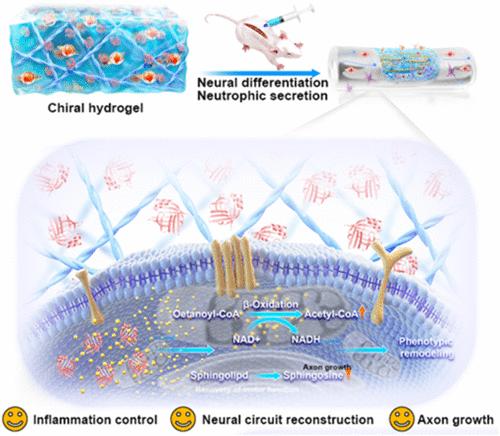手性纳米纤维对脊髓损伤神经干细胞代谢重编程的研究
IF 16
1区 材料科学
Q1 CHEMISTRY, MULTIDISCIPLINARY
引用次数: 0
摘要
外源性神经干细胞(NSCs)具有重建损伤脊髓神经回路的巨大潜力。然而,调节NSCs的代谢重编程以实现可靠的神经再生一直是一个挑战。本文讨论了一种具有右手纳米纤维的仿生右旋水凝胶(DH),它可以特异性地重编程NSCs的脂质代谢,促进其神经分化和受损轴突的快速再生。其潜在机制是DH与脂肪酸结合蛋白5 (FABP5)之间固有的立体选择性,这促进了与FABP5结合的脂肪酸运输到线粒体和内质网,从而增加脂肪酸氧化(FAO)水平,丰富鞘氨醇的生物合成。在大鼠脊髓损伤模型中,与未治疗组相比,DH显著改善了BBB (Basso-Beattie-Bresnahan)运动评分(超过3倍)和后肢复合肌动作电位(超过4倍),功能恢复明显恢复。这一纳米级手性依赖性NSCs代谢重编程的发现为理解干细胞生理学提供了见解,并为再生医学提供了机会。本文章由计算机程序翻译,如有差异,请以英文原文为准。

Metabolic Reprogramming of Neural Stem Cells by Chiral Nanofiber for Spinal Cord Injury
Exogenous neural stem cells (NSCs) have great potential to reconstitute damage spinal neural circuitry. However, regulating the metabolic reprogramming of NSCs for reliable nerve regeneration has been challenging. This report discusses the biomimetic dextral hydrogel (DH) with right-handed nanofibers that specifically reprograms the lipid metabolism of NSCs, promoting their neural differentiation and rapid regeneration of damaged axons. The underlying mechanism is the intrinsic stereoselectivity between DH and fatty acid-binding protein 5 (FABP5), which facilitates the transportation of fatty acids bound to FABP5 into the mitochondria and endoplasmic reticulum, subsequently augmenting fatty acid oxidation (FAO) levels and enriching sphingosine biosynthesis. In the rat SCI model, DH significantly improved the Basso–Beattie–Bresnahan (BBB) locomotor scores (over 3-fold) and the hindlimbs’ compound muscle action potential (over 4-fold) compared with the untreated group, conveying a significant return of functional recovery. This finding of nanoscale chirality-dependent NSCs metabolic reprogramming provides insights into understanding stem cell physiology and presents opportunities for regenerative medicine.
求助全文
通过发布文献求助,成功后即可免费获取论文全文。
去求助
来源期刊

ACS Nano
工程技术-材料科学:综合
CiteScore
26.00
自引率
4.10%
发文量
1627
审稿时长
1.7 months
期刊介绍:
ACS Nano, published monthly, serves as an international forum for comprehensive articles on nanoscience and nanotechnology research at the intersections of chemistry, biology, materials science, physics, and engineering. The journal fosters communication among scientists in these communities, facilitating collaboration, new research opportunities, and advancements through discoveries. ACS Nano covers synthesis, assembly, characterization, theory, and simulation of nanostructures, nanobiotechnology, nanofabrication, methods and tools for nanoscience and nanotechnology, and self- and directed-assembly. Alongside original research articles, it offers thorough reviews, perspectives on cutting-edge research, and discussions envisioning the future of nanoscience and nanotechnology.
 求助内容:
求助内容: 应助结果提醒方式:
应助结果提醒方式:


